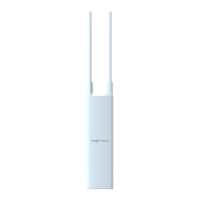
Do you have a question about the Ruijie Reyee RG-RAP52-OD and is the answer not in the manual?
| Brand | Ruijie |
|---|---|
| Model | Reyee RG-RAP52-OD |
| Category | Wireless Access Point |
| Language | English |
Target users for this document.
Contact information and resources for technical assistance.
Explains symbols, signs, and formatting used in the manual.
Specifies browser, resolution, and system requirements for configuration.
Details default IP address, username, and password.
Steps to connect to the access point and log into the web interface.
Explains the different operational modes (Router, AP, Repeater).
Guides users through initial setup for router mode.
Initial steps for powering on and connecting the device in AP mode.
Steps to configure SSID, Wi-Fi password, and management password in AP mode.
Prerequisites for configuring wireless repeater mode.
Steps to set up the device as a wireless repeater.
Details the interface for managing a single device or network.
Describes the interface for managing multiple devices.
How to view device status, topology, and traffic flow.
Procedures for adding new devices to the network.
How to manage existing devices in the network list.
Setting up network topology, including VLANs.
How to view and handle network fault alerts.
Organizing APs into groups for batch configuration.
Steps to set up Wi-Fi network name and security.
How to conceal the Wi-Fi network name for enhanced security.
Viewing and managing connected wireless clients.
Setting up 2.4GHz and 5GHz Wi-Fi bands.
Optimizing client connections to 2.4GHz or 5GHz bands.
Enabling and configuring Wi-Fi 6 features for higher speeds.
Enhancing client roaming experience across VLANs.
Isolating clients within the same Wi-Fi network.
Creating new Wi-Fi networks.
Setting up a separate Wi-Fi network for guests.
Managing bandwidth for clients and SSIDs.
Controlling access based on MAC addresses.
Adjusting AP power and coverage for specific conditions.
Prioritizing gaming traffic for better experience.
Scheduling Wi-Fi availability.
Setting up and managing Reyee Mesh networks.
Distributing client load across APs.
Setting up user authentication for network access.
Selecting the best Wi-Fi channel for reduced interference.
Adjusting channel width for stability or speed.
Adjusting signal strength for optimal coverage.
Optimizing multicast packet handling.
Setting the maximum number of clients per AP.
Managing client disconnections based on signal strength.
Adjusting how quickly clients switch APs.
Setting signal strength threshold for client detection.
Adjusting signal strength for client detection.
Optimizing the self-organizing network for performance.
Improving seamless roaming using 802.11k/v standards.
Changing the device's operational mode (Router, AP, Repeater).
Identifying the role (Master/Slave) of devices in the network.
Setting up the IPv4 connection method (DHCP, PPPoE, Static IP).
Configuring settings for the LAN ports.
Setting up the device to act as a wireless repeater.
Segmenting the network into virtual LANs.
Assigning VLANs to specific network ports.
Modifying the MAC address of the WAN port.
Adjusting the Maximum Transmission Unit for network performance.
Setting up the device as a DHCP server.
Setting up DNS server addresses.
Enabling hardware acceleration for improved performance.
Managing network traffic flow on ports.
Enhancing network security by binding IP to MAC addresses.
Configuring settings for LAN ports, including VLAN assignment.
Understanding IPv6 address formats and concepts.
Details on IPv6 network and interface identifiers.
Information on specific types of IPv6 addresses.
Understanding IPv6 to IPv6 Network Address Translation.
Methods for assigning IPv6 addresses (Manual, SLAAC, DHCPv6).
Steps to enable IPv6 functionality on the device.
Setting IPv6 address for the WAN interface.
Setting IPv6 address for LAN ports.
Monitoring clients obtaining IPv6 addresses via DHCPv6.
Assigning static IPv6 addresses to clients.
Managing IPv6 neighbor discovery information.
Configuring Power over Ethernet settings for the access point.
Changing the password for accessing the device.
Configuring how long a user session remains active.
Setting and viewing the device's current time and time zone.
Managing device reboots.
Scheduling automatic device reboots.
Backing up and restoring device configurations.
Resetting the device to its default factory configuration.
Updating device firmware and checking versions.
Changing the user interface language.
Managing the status lights (LEDs) on access points.
Performing a diagnostic check to identify network issues.
Using tools like Ping and Traceroute for network analysis.
Viewing and managing system alarms and alerts.
Gathering diagnostic information for troubleshooting.
Troubleshooting steps for issues logging into the management system.
How to restore the device to its factory default settings.
Procedures for recovering lost login or Wi-Fi passwords.